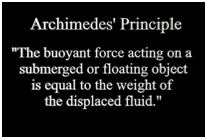


That is why a boat can float.
Iona Physics
Laboratory Demonstration: Buoyancy
DEFINITION: Upthrust - the upward force on an object which is immersed in a fluid (liquid or gas). [This is why objects appear to weigh less when immersed in a fluid.]
 |
 |
The object seems to weigh less when it is submerged. The amount of weight it seems to have lost is equal to the weight of the displaced fluid. If the weight of the displaced fluid equals the weight of the object, then the object will float! |
That is why a boat can float. |
We will use a variation of the experiment shown in the diagram above.
Procedure:
We will determine the weight of a brick in air, then when submerged in water, and try to verify Archimedes’ Principle.
Data:
Weight of the brick in air (alone) _____________
Weight of the water and pan (alone) _____________
Total Weight _____________
When the brick is immersed in the water:
Apparent weight of the brick _____________
Apparent weight of the water and pan _____________
How much weight the brick "lost": _____________
How much weight the pan "gained": _____________
You will use another variation on this principle to find the Specific Gravity
of a piece of metal.